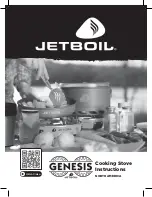
4
chimney and the low temperature of the fresh
air. The length and insulation of the chimney,
wind and weather conditions also have an effect
on the ability of the chimney to generate appro-
priate under-pressure.
If the stove has not been used in a while, check
that the chimney and stove are not blocked with
soot, bird nests, etc., before using it.
Reduced draft can occur when:
• The difference in temperature is too small
– due to insufficient chimney insulation, for
example.
• The outdoor temperature is too high – in
summer, for example.
• No wind is blowing.
• The chimney is too low and sheltered.
•
• The chimney contains false air.
• The chimney and flue gas pipe are blocked.
• The house is too airtight (i.e. when there is
an insufficient supply of fresh air).
• Poor smoke extraction (poor draft conditi-
ons) due to a cold chimney or bad weather
conditions can be compensated for by
increasing the airflow into the stove.
Good draft occurs when:
• The difference in temperature between the
chimney and outdoor air is high.
• The weather is fine.
• The wind is blowing strongly.
The chimney is of the correct height: at least
4.00 m above the stove and free of the roof
ridge.
INSTRUCTIONS FOR USE
First firing
The stove paint is fully cured from the factory,
but a minor unpleasant odour could still arise.
Fuel
Your new stove is EN approved for firing with
wood fuel. You must therefore only burn clean,
dry wood in your stove. Never use your stove
to burn driftwood, as this may contain a lot of
salt which can damage both the stove and the
chimney. Similarly, you must not fire your stove
with refuse, painted wood, pressure-impregna-
ted wood or chipboard, as these materials can
emit poisonous fumes and smoke. Correct fi-
ring using well seasoned wood provides opti-
mal heat output and maximum economy. At the
same time, correct firing prevents environmental
damage in the form of smoke and emmissions
and also reduces the risk of chimney fires. If the
wood is wet and inadequately seasoned, a large
proportion of the energy in the fuel will be used
to vaporise the water, and this will all disappear
up the chimney. Thus it is important to use dry,
well seasoned wood, i.e. wood with a moisture
content of no more than 20%. This is achieved
by storing the wood for 1–2 years before use.
Pieces of firewood with a diameter of more than
10 cm should be split before storing. The pieces
of firewood should be of an appropriate length
so that they can lie flat on the bed of embers. If
you store your wood outdoors, it is best to cover
it.
Examples of recommended
woods types
and their typical specific gravity per cubic
meter stated as 100% wood with a moisture
content of 18%
Wood
kg/m
3
Wood
kg/m
3
Beech
710
Willow
560
Oak
700
Alder
540
Ash
700
Scotch pine
520
Elm
690
Larch
520
Maple
660
Lime
510
Birch
620
Spruce
450
Mountain pine 600
Poplar
450
It is advised not to use very oil-containing
woods like teak tree and mahogany, as this
can cause damage to the glass.
Heating value in wood
You have to use about 2.4 kg normal wood to
replace one litre of heating oil. All woods have
almost the same heating value per kg, which
is about 5.27 kW/hour for absolute dry wood.
Wood with a moistness of 18% has a efficiency
of about 4.18 kW/hour per kg, and one litre hea-
ting oil contains about 10 kW/hour.
CO
2
release
At combustion 1000 litres of heating oil forms
3.171 tons CO
2
. As wood is a CO
2
neutral heat/
energy source, you save the environment about
Summary of Contents for SCAN-LINE 805 AQUA
Page 12: ...12 ...






























